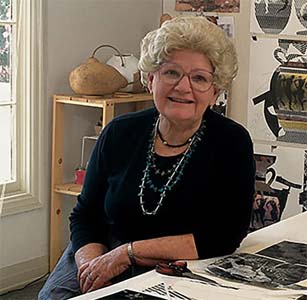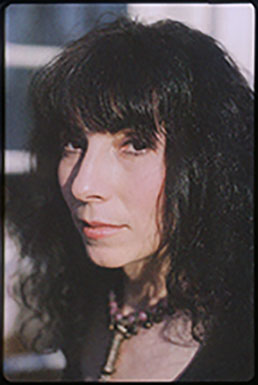Related Research Articles

Crewel embroidery, or crewelwork, is a type of surface embroidery using wool. A wide variety of different embroidery stitches are used to follow a design outline applied to the fabric. The technique is at least a thousand years old.

The Cleveland Museum of Art (CMA) is an art museum in Cleveland, Ohio, United States. Located in the Wade Park District of University Circle, the museum is internationally renowned for its substantial holdings of Asian and Egyptian art and houses a diverse permanent collection of more than 61,000 works of art from around the world. The museum provides free general admission to the public. With a $920 million endowment (2023), it is the fourth-wealthiest art museum in the United States. With about 770,000 visitors annually (2018), it is one of the most visited art museums in the world.
Events from the year 1988 in art.

Leonard Baskin was an American sculptor, draughtsman and graphic artist, as well as founder of the Gehenna Press (1942–2000). One of America's first fine arts presses, it went on to become "one of the most important and comprehensive art presses of the world", often featuring the work of celebrated poets, such as Sylvia Plath, Ted Hughes, Anthony Hecht, and James Baldwin side by side with Baskin's bold, stark, energetic and often dramatic black-and-white prints. Called a "Sculptor of Stark Memorials" by the New York Times, Baskin is also known for his wood, limestone, bronze, and large-scale woodblock prints, which ranged from naturalistic to fanciful, and were frequently grotesque, featuring bloated figures or humans merging with animals. "His monumental bronze sculpture, The Funeral Cortege, graces the Franklin Delano Roosevelt Memorial in Washington, D.C."
Sue Coe is an English artist and illustrator working primarily in drawing, printmaking, and in the form of illustrated books and comics. Her work is in the tradition of social protest art and is highly political. Coe's work often includes animal rights commentary, though she also creates work that centralizes the rights of marginalized peoples and criticizes capitalism. Her commentary on political events and social injustice are published in newspapers, magazines and books. Her work has been shown internationally in both solo and group exhibitions and has been collected by various international museums. She lives in Upstate New York.
The Holocaust has been a prominent subject of art and literature throughout the second half of the twentieth century. There is a wide range of ways–including dance, film, literature, music, and television–in which the Holocaust has been represented in the arts and popular culture.

Henryk Ross was a Polish Jewish photographer who was employed by the Department of Statistics for the Jewish Council within the Łódź Ghetto during the Holocaust in occupied Poland.

Jack Lenor Larsen was an American textile designer, author, collector and promoter of traditional and contemporary craftsmanship. He was noted for bringing fabric patterns and textiles to go with modernist architecture and furnishings. Some of his works are part of permanent collections at museums, including the Museum of Modern Art, the Victoria and Albert Museum, the Art Institute of Chicago, the Musée des Arts Décoratifs at the Louvre, and the Minneapolis Institute of Art, which has his most significant archive.

Susan Schwalb is a contemporary silverpoint artist.

Alvin D. Loving Jr., better known as Al Loving, was an African-American abstract expressionist painter. His work is known for hard-edge abstraction, dyed fabric paintings, and large paper collages, all exploring complicated color relationships.

Katherine Westphal was an American textile designer and fiber artist who helped to establish quilting as a fine art form.
Ina Golub, born Ina Joan Rudman was a fiber artist who specialized in Judaica.

Françoise Grossen is a textile artist known for her braided and knotted rope sculptures. She lives and works in New York City. Grossen’s work has been acquired by the Metropolitan Museum of Art, New York; the Renwick Gallery, Smithsonian American Art Museum, Washington, DC; and the State Hermitage Museum, Saint Petersburg, Russia.
Wall Hangings was an exhibition of textile fiber art at Museum of Modern Art from 25 February to 4 May 1969. It was planned in 1966 and toured 11 cities in 1968–1969.

The Holocaust Wall Hangings by Judith Weinshall Liberman are a series of sixty loose-hanging fabric banners of varying sizes created between 1988 and 2002. They illustrate the plight of the Jewish people and other minorities during the Holocaust of World War II.
Rita Briansky is a Polish-born Canadian painter and printmaker. Briansky is associated with the Jewish Painters of Montreal.
Judith Peck is an American artist currently residing in the Greater Washington, D.C. area who is predominantly known for her allegorical figurative oil paintings.
Naomi Ityi (1928–2003) was a Canadian Inuit artist. Ityi was born in the Garry Lake area of the Nunavut. She is known for her collaged wall hangings made from wool scraps. Her sister Martha Qarliksaq is also an artist.

Bernis von zur Muehlen, born 1942, is an American fine arts photographer.
Sherri Smith is an American fiber and textile artist, weaver, sculptor, and educator. She is one of the pioneers within the field of fiber art since the late 1960s. Smith taught for many years at the University of Michigan (UMich) in Ann Arbor, where she is the Catherine B. Heller Collegiate Professor Emerita. In 2012, she was named a fellow of the American Craft Council (ACC).
References
- ↑ "Jewish museum features Holocaust horror". NBC News. Retrieved 19 April 2018.
- ↑ "Judith Weinshall Liberman, '54: A Life into Art". University of Chicago Law School . Retrieved 14 April 2018.
- 1 2 3 4 5 "Judith Weinshall Liberman, Curriculum Vitae". jliberman.com. Retrieved 23 April 2018.
- ↑ "School of the Museum of Fine Arts". Tufts University . Retrieved 10 May 2018.
- 1 2 Harrison, Helen A. (28 February 1999). "Art Reviews; Unorthodox Uses of Paper and Other Materials". The New York Times . Sec. N.Y. / Region. Retrieved 19 April 2018.
- 1 2 3 "Jewish museum features Holocaust Horror". Beachwood, Ohio: NBC News. Associated Press. 12 December 2006. Retrieved 19 April 2018.
- ↑ "Holocaust Wall Hangings". Holocaust Teacher Resource Center site. Retrieved 19 April 2018.
- ↑ Bennett, Lennie. "Review: Artist of Great Mind and Talent has a Show One Flight Up at Florida Holocaust Museum". Tampa Bay Times. Retrieved 19 April 2018.
- 1 2 Heller, Fran. "Powerful Works on Fabric a Tribute to Holocaust". Cleveland Jewish News. Retrieved 19 April 2018.
- ↑ Heller, Fran. "Powerful works on fabric a tribute to Holocaust". Cleveland Jewish News . Retrieved 17 April 2018.
- ↑ "Judith Weinshall-Liberman Papers – 13348". The Smithsonian Institution, Archives of American Art. Retrieved 10 May 2018.
- ↑ "ArchiveGrid Weinshall-Liberman Family Papers, 1915–1995". worldcat.org. Retrieved 13 April 2018.
- ↑ "Holocaust Wall Hangings". Boston Public Library. Retrieved 23 April 2018– via Archive.org.